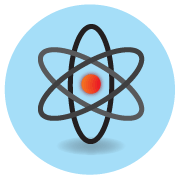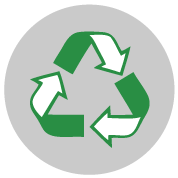Generation Sources
Electricity generation is the process of converting primary energy sources such as coal, natural gas or wind into electrical power. Electricity is produced when a magnet is moved near a wire to create a steady flow of electrons. The flow of electrons is an electrical current or electricity.
We call any device that completes this task a “generator.” Primary energy sources, such as wind or natural gas, power these generators by rotating a turbine that is attached to the shaft of the generator. For example, wind blows and rotates those huge turbines seen in wind farms. The turbines then rotate the shaft of the generator, which causes the magnet to rotate inside the wires and creates electrical energy. This process is the first step in delivering electricity to consumers and is performed by electricity generators at power plants. From power plants, electricity is then transported to homes, schools and businesses through transmission and distribution wires.
Primary sources of energy can be divided into conventional and renewable fuel types. All of these different sources make up the generation fuel mix in PJM. You can see the current generation fuel mix on the Markets & Operations homepage. Here are a few examples of how energy sources work to produce electrical energy.
 |
Coal: Coal is a black or dark brown rock consisting mainly of carbonized (converted into carbon, typically by heating or burning, or during fossilization) plant matter, found mainly in underground deposits that must be mined. Energy is created from coal through burning it to produce heat. This combustion takes place in a furnace with a boiler. The furnace heat converts water to steam, which then spins turbines, which turn a generator to produce electricity.
|
 |
Natural Gas: Natural gas is a flammable gas that occurs naturally underground. Similar to coal, natural gas is burned to generate heat that boils water into steam to turn the turbines that generate electricity. Hot gases from burning the natural gas also can directly turn the turbine.
Other Gas: Industrial processes produce gases that can be captured and burned to produce energy.
|
 |
Nuclear: The primary source of energy for nuclear power is uranium. In a nuclear energy facility, heat is produced from splitting uranium atoms – a natural process called nuclear fission. As with other resources, the heat creates steam and the steam turns a turbine connected to a generator.
|
 |
Hydro: Hydroelectric power uses falling water to produce electric power. Hydroelectric power plants usually have dams that block water from freely flowing on its normal path. Instead, water flows through a small, narrow passageway. As the water is forced through this narrow passage, the flow of water speeds up and is forced through a turbine, which spins as the water rushes through it. The turbine is connected to a generator shaft, which turns the generator and creates electrical current.
|
 |
Wind: The blades of a wind turbine capture the energy in wind. The wind causes them to rotate (similar to blowing on a pinwheel). The rotation of the turbines is tied to a generator that produces electrical energy.
|
 |
Solar: Solar energy generation begins with sunlight captured by a solar panel. You may have seen the large, often rectangular panels on the roof of a home or business or in a large group on the ground. These panels contain crystals that, when struck by sunlight, produce an electrical current.
|
 |
Captured Methane: Methane gas is captured from landfills or other sources as trash decomposes. The methane rises to the top of the landfill and is collected in pipes; then it produces electricity when it is burned.
|
 |
Pumped Storage: Water is pumped into a reservoir. During peak demand hours, water flows down from the plant reservoir to generate electricity. The water is pumped back into the reservoir during off-peak hours.
|
 |
Wood Waste: Fuel derived from both liquid and solid wood wastes is used to produce electricity. Wood waste liquids come from the pulp and paper industries. Solids include railroad ties, utility poles and wood chips.
|
 |
Biomass: Biomass is derived from organic materials such as scrap wood, crops and some types of waste residues. It can be used to generate heat and electricity. Biomass fuels can be solids, gases or liquids that result from living organisms or from the byproducts of human activities. |
 |
Solid Waste: Energy is produced from solid waste by burning the waste as a fuel.
|
Conventional fuel types include coal, natural gas, oil and nuclear materials. These primary sources of energy cannot be replenished once used. Renewable fuel types include wind, solar, hydro, geothermal heat and tidal waves. Renewable sources of energy can be replenished. Each of these fuel sources contributes in different ways to the electrical energy that we use when turn on our TVs or run our dishwashers.